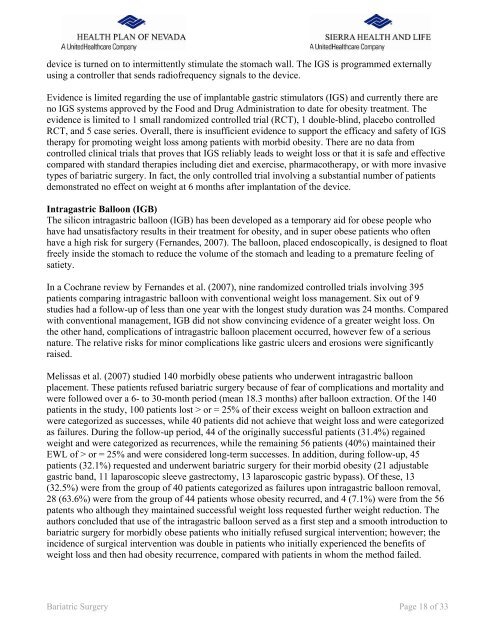BARIATRIC SURGERY - Health Plan of Nevada
BARIATRIC SURGERY - Health Plan of Nevada
BARIATRIC SURGERY - Health Plan of Nevada
You also want an ePaper? Increase the reach of your titles
YUMPU automatically turns print PDFs into web optimized ePapers that Google loves.
device is turned on to intermittently stimulate the stomach wall. The IGS is programmed externally<br />
using a controller that sends radi<strong>of</strong>requency signals to the device.<br />
Evidence is limited regarding the use <strong>of</strong> implantable gastric stimulators (IGS) and currently there are<br />
no IGS systems approved by the Food and Drug Administration to date for obesity treatment. The<br />
evidence is limited to 1 small randomized controlled trial (RCT), 1 double-blind, placebo controlled<br />
RCT, and 5 case series. Overall, there is insufficient evidence to support the efficacy and safety <strong>of</strong> IGS<br />
therapy for promoting weight loss among patients with morbid obesity. There are no data from<br />
controlled clinical trials that proves that IGS reliably leads to weight loss or that it is safe and effective<br />
compared with standard therapies including diet and exercise, pharmacotherapy, or with more invasive<br />
types <strong>of</strong> bariatric surgery. In fact, the only controlled trial involving a substantial number <strong>of</strong> patients<br />
demonstrated no effect on weight at 6 months after implantation <strong>of</strong> the device.<br />
Intragastric Balloon (IGB)<br />
The silicon intragastric balloon (IGB) has been developed as a temporary aid for obese people who<br />
have had unsatisfactory results in their treatment for obesity, and in super obese patients who <strong>of</strong>ten<br />
have a high risk for surgery (Fernandes, 2007). The balloon, placed endoscopically, is designed to float<br />
freely inside the stomach to reduce the volume <strong>of</strong> the stomach and leading to a premature feeling <strong>of</strong><br />
satiety.<br />
In a Cochrane review by Fernandes et al. (2007), nine randomized controlled trials involving 395<br />
patients comparing intragastric balloon with conventional weight loss management. Six out <strong>of</strong> 9<br />
studies had a follow-up <strong>of</strong> less than one year with the longest study duration was 24 months. Compared<br />
with conventional management, IGB did not show convincing evidence <strong>of</strong> a greater weight loss. On<br />
the other hand, complications <strong>of</strong> intragastric balloon placement occurred, however few <strong>of</strong> a serious<br />
nature. The relative risks for minor complications like gastric ulcers and erosions were significantly<br />
raised.<br />
Melissas et al. (2007) studied 140 morbidly obese patients who underwent intragastric balloon<br />
placement. These patients refused bariatric surgery because <strong>of</strong> fear <strong>of</strong> complications and mortality and<br />
were followed over a 6- to 30-month period (mean 18.3 months) after balloon extraction. Of the 140<br />
patients in the study, 100 patients lost > or = 25% <strong>of</strong> their excess weight on balloon extraction and<br />
were categorized as successes, while 40 patients did not achieve that weight loss and were categorized<br />
as failures. During the follow-up period, 44 <strong>of</strong> the originally successful patients (31.4%) regained<br />
weight and were categorized as recurrences, while the remaining 56 patients (40%) maintained their<br />
EWL <strong>of</strong> > or = 25% and were considered long-term successes. In addition, during follow-up, 45<br />
patients (32.1%) requested and underwent bariatric surgery for their morbid obesity (21 adjustable<br />
gastric band, 11 laparoscopic sleeve gastrectomy, 13 laparoscopic gastric bypass). Of these, 13<br />
(32.5%) were from the group <strong>of</strong> 40 patients categorized as failures upon intragastric balloon removal,<br />
28 (63.6%) were from the group <strong>of</strong> 44 patients whose obesity recurred, and 4 (7.1%) were from the 56<br />
patents who although they maintained successful weight loss requested further weight reduction. The<br />
authors concluded that use <strong>of</strong> the intragastric balloon served as a first step and a smooth introduction to<br />
bariatric surgery for morbidly obese patients who initially refused surgical intervention; however; the<br />
incidence <strong>of</strong> surgical intervention was double in patients who initially experienced the benefits <strong>of</strong><br />
weight loss and then had obesity recurrence, compared with patients in whom the method failed.<br />
Bariatric Surgery Page 18 <strong>of</strong> 33

















